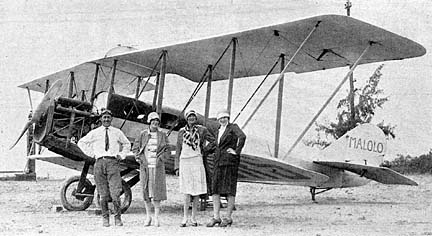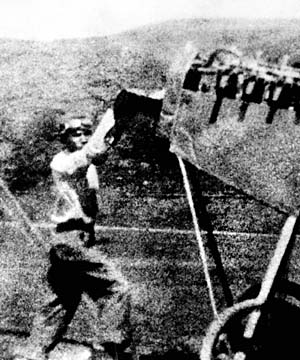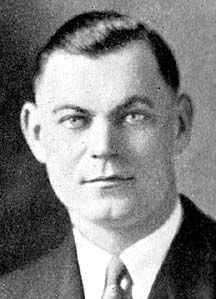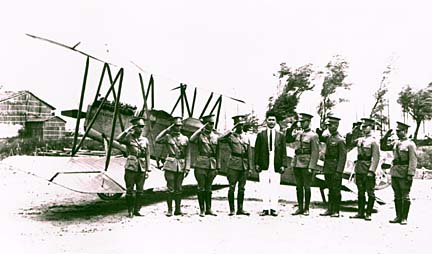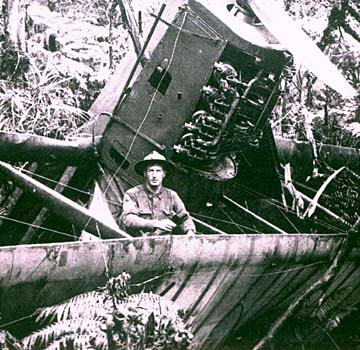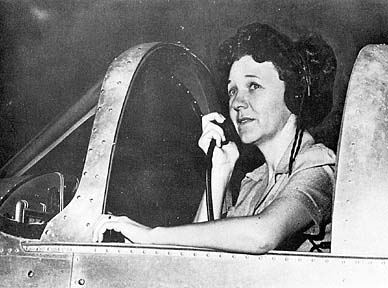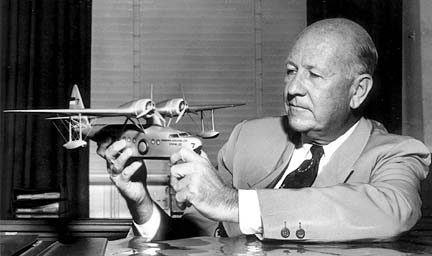
Pioneers
in Hawaiian
aviation history
THERE is no "Hall of Fame" for the people who created Hawaii's aerospace heritage, but if there were, who would be in it? The pioneers, the businessmen, the engineers, the visionaries, the dreamers and the adventurers who dared explore the wild blue yonder -- here are some we chose to start it off. Some are famous, some are simply well-known, other are obscure, but all of them opened our skies.
Ellison Onizuka
Space ExplorerKealakekua's Ellison Onizuka joined the Air Force in 1970 and became an aerospace flight test engineer with the Sacramento Air Logistics Center. He attended the USAF Test Pilot School and was assigned to the Flight Test Center at Edwards Air Force Base, Calif.
Selected as an astronaut candidate in 1978, Onizuka first flew as a mission specialist on STS 51-C, the first space shuttle Department of Defense mission in 1985, logging 74 hours in space.
A mission specialist on STS 51-L, he was among the crew killed when the orbiter Challenger exploded on Jan. 28, 1986, a minute after launching from Cape Canaveral.
Bud Mars
BURL BURLINGAME AIRCHIVE
BarnstormerIn the closing days of 1910, touring aviator J.C. "Bud" Mars arrived in the islands with two disassembled Curtiss pusher aeroplanes. Even though he was known as one of the most daring aviators in the country, Mars refused to carry female passengers, even though one woman demonstrated her fearlessness by climbing out on the fourth-floor ledge of the Alexander Young Hotel.
Mars was ready to fly on New Year's Eve, 1910, and the Curtiss took off from the Moanalua polo grounds and climbed to 500 feet. The crowd cheered the "Honolulu Skylark."
It was the first powered flight in Hawaii. Mars made three more flights that day, one at the incredible height of 1,500 feet.
When Mars returned the next day to make more flights, he was annoyed to find that thousands of spectators had taken to the hills rather than pay admission to the event. He called them "pikers" and "deadheads" and left town.
Amelia Earhart
AviatrixAlthough there were more talented female pilots, none was better at promoting aviation's lure than Amelia Earhart. One of the best-known Americans in history, Earhart made her mark with a solo flight from Honolulu to Oakland on Jan. 8, 1935.
It was the first-ever solo flight linking Hawaii to the mainland. Even though Earhart flew east rather than west to simplify navigation problems, her landfall on the West Coast was off by only a few miles.
During an around-the-world flight in 1937, Earhart had an accident on Ford Island and later disappeared over the Pacific, flying into legend.
Tom Gunn
BURL BURLINGAME AIRCHIVE
BarnstormerBorn in San Francisco, Tom Gunn represented China in the 1910 International Aviation Meet in Los Angeles and was dubbed the "Wright of China." When revolution erupted, Gunn was contacted by Sun Yat-Sen to popularize aviation. In two years, Gunn made more than 800 flights and carried more than 300 passengers in the Pacific region, including the Hawaiian Islands, where he also demonstrated the first flying boat seen here.
The first airplane passenger in Hawaii, a young woman who sold tickets for the Empire Theatre, was taken aloft by Gunn on July 13, 1913, in a "vaudeville show" that included a mail-service demonstration, gliding with the engine switched off and a maneuver called the "Dip of Death."
Later, Gunn charged $25 to carry Hawaii's first paying passenger, a Mrs. Newman of Honolulu.
Sponsored by the Nippu Jiji, a Japanese-language newspaper, Gunn went on to the neighbor islands and the Philippines to inaugurate air-mail services before settling in China to fly for Sun Yat-Sen.
John Rodgers
BURL BURLINGAME AIRCHIVE
TrailblazerThere was no margin for error, but the Navy was determined to fly from the mainland to the Hawaiian Islands, and turned to the commander of the Ford Island Naval Air Station, John Rodgers.
He decided on a mass flight of three flying boats, the Naval Aircraft Factory PN-9 Nos. 1 and 3, and an experimental Boeing model called the PB-1.
On the day of the flight, the PB-1 wasn't ready and PN-9 No. 3 turned back with engine difficulties.
The remaining PN-9 flew on alone. And it vanished over the Pacific.
Coming on the heels of the Navy's Shenandoan airship disaster, a massive search was instituted for Rodgers and his crew, but to no avail. But Rodgers had set down on the ocean, out of fuel, pulled fabric off the wings, tied it to the struts and sailed it to Hawaii like some sort of ship.
Despite days of no food and water, Rodgers' navigation placed them right off Nawiliwili Harbor on Kauai.
Hawaii went wild, and Rodgers and crew were feted as heroes. The first real airport in the isles was named for him, and today the Honolulu International Airport's main building is still called John Rodgers Terminal.
Edwin Lewis
AVIATION IN HAWAII
Businessman PilotOne regular visitor to every early flight in the islands was businessman Edwin Lewis, who introduced automobiles to Hawaii. He was the primary sponsor of Bud Mars' first flight at Moanalua Polo Grounds, and he also established the first real airport in Hawaii, called Ala Moana Field.
Even though Lewis didn't learn to fly until he was in his 50s, he became an enthusiastic promoter of the industry, owning and flying more than a dozen airplanes.
Lewis' greatest contribution, however, was the establishment of Lewis Air Tours in the late 1920s. Flying a Standard biplane named Malolo -- "flying fish" -- that sported an enclosed cabin for passenger comfort, tourists and locals alike were treated to views of the islands unimaginable just a few years before. His pilots included Martin Jensen, who later gained fame in the Dole Derby air race.
Lewis later partnered with Star-Bulletin typesetter Olen V. Andrews in the Andrews Flying Service. Today, the air-tour business continues to thrive in the islands.
Shigeru Serikaku
WAIPAHU CULTURAL GARDEN PARK
InventorOkinawan automobile mechanic Shigeru Serikaku was fascinated by aviation and spent every spare moment and penny absorbing the engineering of the period. Acquiring a French four-cylinder engine, he began building an aircraft of his own design in his Waipahu garage, a project that drew dozens of spectators. Many paid a dollar each to Serikaku to defray costs.
Serikaku carefully measured the plane's thrust by staking it down and using a scale tied to the rope. Once he accidentally walked into the spinning prop and was badly injured.
One day in 1914, Serikaku simply took off, circled several times and landed, the first successful flight of a Hawaii-built airplane.
Robert L. Tyce
InstructorAlmost everyone who learned to fly in Hawaii in the 1930s sat next to instructor Robert Tyce, who began teaching the art of aeronautics before the word had been invented.
An early barnstormer, beating up the skies of Nevada and Arizona, Tyce formed his first permanent school in Chula Vista, Calif., in 1922, and also formed an aerial police corps, the Chula Vista Sheriff's Aero Squadron.
After moving to Hawaii, Tyce continued to teach the basics of flying to hundreds of students.
On Dec. 7, 1941, as Tyce worked on a Hawaiian Airlines DC-3 at John Rodgers Field, Zero fighter planes strafed the runway and hangars. Civilian aircraft were the only non-military targets hit by the Japanese, and two were shot down, the pilots killed. Tyce was also killed in the strafing attack, and his name is listed among the dead at the Arizona Memorial Visitors Center.
Charles Elliott
Senior pilotWhen Inter-Island Airways began the first commercial airline in Hawaii, the company needed a senior pilot who could inspire confidence in dubious passengers. They turned to Charles Elliott, a Navy veteran and Pensacola flight instructor later stationed in Hawaii with Fighting Plane Squadron 2. When he was hired by Inter-Island, Elliott had more than 7,000 hours of flying experience, an extraordinary total for that era.
The first flight of Inter-Island Airways had Elliott at the controls, and the Sikorsky S-38 amphibian was escorted by 47 Navy and Army airplanes in a mass formation. Three hours later, Elliott touched down in Hilo, completing the first flight for what later became Hawaiian Airlines.
Elliott continued flying for Inter-Island and Hawaiian for another couple of decades, never having an accident while ferrying passengers.
Lester Maitland and Albert Hegenberger
BURL BURLINGAME AIRCHIVE
TrailblazersIn the excitement over Lindbergh's solo hop across the Atlantic, dozens of record-breaking flights were attempted. One obvious choice was the primary leg across the Pacific, connecting Hawaii to the mainland. It was the longest direct route that could be flown in those days with encountering land.
The Navy tried in 1925 and ran out of fuel. The Army was determined to try, and the answer seemed to be the new tri-motored Atlantic Fokker C-2, a transport capable of carrying tons of fuel. The other problem was navigation, and the Army's best aerial navigator was Lt. Albert Hegenberger, who suggested using smoke bombs as drift markers.
The pilot chosen was Lt. Lester Maitland, who pioneered interisland flights while stationed at Ford Island during the Great War, and also flew Army racers.
Their aircraft was named "Bird of Paradise" and it took off from Oakland on June 28, 1927. For nearly 24 hours, the plane bore southwest in darkness and rain. Hegenberger's navigation was marred by a crosswind, and just before dawn they spotted the last rays of a lighthouse on the north shore of Kauai.
Their position fixed, the Fokker made for Oahu and landed at 6:29 a.m. June 29 at Wheeler Field, completing the first successful flight to Hawaii. Many more were to follow.
Sen Yat Young
BURL BURLINGAME AIRCHIVE
Patriot PilotIolani graduate Sen Yat Young, a fan of Chinese nationalist Sun Yat-Sen, was also fascinated by all things mechanical and aeronautical, He went to gain a pilot's license from the Curtiss Aviation School in upstate New York, the first Hawaii resident to do so.
After flying in Hawaii, Young went to China in 1918 to organize the new nation's air force. Three years later, he toured Japan, Mexico and the United States to raise enough money to buy aircraft and equuipment. He also inspired overseas Chinese to return to their native land as aviators and patriots.
As Chief of Aviation for the Kwangtung government, Young designed and built China's first aircraft, nicknamed "Rosamond," after Sun Yat-Sen's wife Soong Ching Ling. In the picture above, Young stands in front of his airplane, flanked by Chinese aviation cadets.
Young was killed in 1923 in a battle with a rival warlord, and Sun Yat Sen posthumously promoted him to general and sent a hand-painted scroll to Young's family that said "Aim High to Reach the Heaven." Young's son Tun-oy Young returned the original scroll to China in 1982 for a memorial.
Young's grandson is Honolulu attorney Leigh-Wai Doo, who is also a founding director of the Dr. Sun Yat-Sen Hawaii Foundation.
Harold Clark
BURL BURLINGAME AIRCHIVE
TrailblazerDespite being scared off by strong tradewinds during an earlier expedition to Hawaii, the experiences of the Great War convinced the Army to raise new aviation squadrons, three of which would be stationed "overseas" -- which included the Territory of Hawaii. The new Hawaiian Air Office set up in the Alexander Young Hotel in November 1916, and, under the command of Capt. John Curry, determined that Ford Island was the most suitable location for a military airfield. Among the personnel assigned to the fledgling unit was Curtiss-trained pilot Maj. Harold Clark, who succeeded Curry as commander.
Clark oversaw an incredible construction effort on Ford Island, creating not just a runway, but hangars, maintenance buildings and quarters in the scrubby wilds of the harbor. Many of the buildings still exist.
Six months after taking over what was now the 6th Aero Squadron, Clark took off with Sgt. Robert Gay in a Curtiss R-6 airplane on May 9, 1918, and flew to Maui, the first interisland flight in Hawaiian history. After a huge reception, the aviators attempted to fly to Hilo. Clouds closed in and Clark climbed to 8,000 feet, hoping to avoid volcanic peaks, but they crashed into a rain forest on Mauna Kea.
It took two days for the tired and hungry aviators to hike to safety.
Marguerite Gambo-Wood
PACIFIC AEROSPACE MUSEUM
Businesswoman PilotAlthough there were a number of female aviators in the islands, such as Emma Ing Chung, Madeline Hayden, Barbara O'Farrell, Irene Ozias and Juanita Wilson, Marguerite Gambo made the biggest splash as a savvy aviation entrepreneur.
Taught to fly by the ubiquitous Robert Tyce, Gambo soloed in 1937 and quickly became rated as a commercial pilot. She was present at island air meets, talking up the future of flying, and she became the Hawaii representative for the Aeronca aircraft factory. In 1939, she founded the Gambo Flying Service, building the first private hangar in the islands, and her orange and blue Aeroncas were well-known in Hawaiian skies. One of her Aeroncas, with Roy Vitousek at the controls, was caught in the air on Dec. 7, 1941, and shot up by the Japanese. This aircraft has been restored and is currently on display at Pearl Harbor. Gambo herself was in the air, teaching a student, when they were caught in a swarm of attacking Zeros. Gambo seized the controls and flipped the aircraft out of harm's way, memorialized in "Tora Tora Tora."
The military banned private aviation in the islands during the war and Gambo married, creating her business again when the war ended. Known to hundreds of students as "Ma Wood," Gambo-Wood continued to define civil aviation. Her estate continues to fund an aviation scholarship in her name.
Stan Kennedy
BURL BURLINGAME AIRCHIVE
Businessman PilotStan Kennedy was already manager of the Inter-Island Steam Navigation Company, but he hankered to go into the flying business. During the Great War, Kennedy had flown patrol missions out of England as a naval aviator, and knew that flying over water was a safe activity.
His father was president of Inter-Island, and Kennedy badgered him to expand into the airline trade. After the success of the Maitland-Hegenberger flight and the excitement of the Lindbergh flight, the territorial legislature passed a resolution exempting any start-up airline from paying taxes for five years. Several aviators created business plans, but Kennedy's expertise in the shipping trade swayed his financial backers.
Purchasing a pair of modern Sikorsky S-38 amphibians and a Bellanca monoplane -- and convincing Charles Elliott to retire from the Navy to become a full-time head pilot -- Kennedy's Inter-Island Airways was ready to go into business.
Then came word that a rival start-up was organizing as well. Incorporated in Nevada, Hawaiian Airways, owners of two Fokker trimotors, planned to begin service in Hawaii.
Kennedy sped up his organization, and on Nov. 11, 1929, the first flight of Inter-Island took place. The governor's daughter broke a bottle of champagne over the nose of an S-38.
Inter-Island later absorbed Hawaiian's assets and renamed itself Hawaiian Airlines, becoming one of the oldest continuously operating airlines in the world. Kennedy was in charge much of that time.





